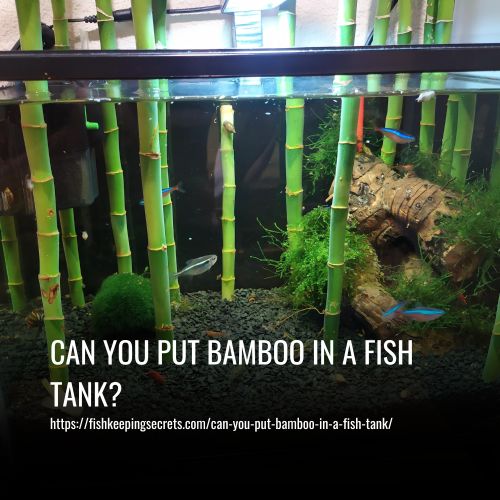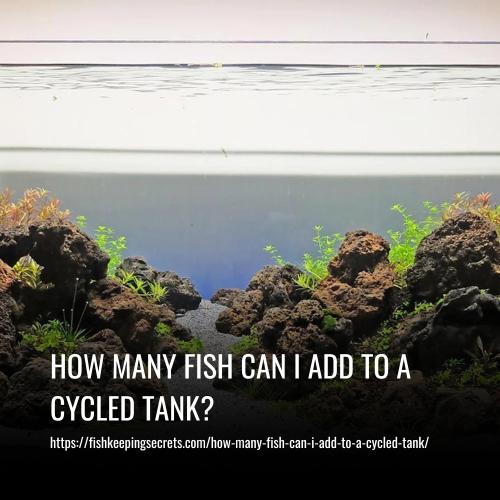If you’re thinking of adding bamboo to your aquarium, you should know that the traditional bamboo plant is not safe for fish. This type of bamboo will decay when put in water and pose a risk to your aquarium inhabitants.
However, the Dracaena sanderiana, or ‘Lucky Bamboo’, is safe for use in aquariums and can be a great addition. It is important to confirm any plants you plan on introducing into an aquarium are safe for the fish living there. When in doubt, research the potential risks associated with adding new plants or decorations to your tank before doing so.

Real Bamboo vs Lucky Bamboo
Bamboo can be toxic to aquarium inhabitants, making true bamboo unsuitable for aquatic habitats. However, lucky bamboo is a suitable alternative as it resembles true bamboo but does not emit ammonia into the water.
To ensure your plants are safe and introduced properly into your tank, it is important to understand how to immerse lucky bamboo in the right way.
Some suggest fully immersing the plant while others claim to keep the leaves out of the water. Keeping the leaves raised above the water helps keep the plant alive and healthy; if they are submerged, it may cause decay and release toxins into your aquarium. It is important to discern between real bamboo and lucky bamboo when investing in aquarium plants, as each one behaves differently within a tank environment.
Having a lucky bamboo plant can make your fish tank look attractive, so be sure to check if what you have is indeed lucky bamboo before adding it to your aquarium.
Lifespan
The debate surrounding the proper care of lucky bamboo has been going on for years. Reports from some aquarists state that lucky bamboo typically only survive for a few years, while other reports suggest they can live beyond ten years.
This makes it difficult to definitively answer this question, but many aquarists have had success with longer lifespans when taking care of their lucky bamboo properly.
In addition to its longevity, lucky bamboo is a versatile plant that can be planted at any height in an aquarium. Smaller stalks are suitable for the foreground or midground while taller stalks integrate into the background.
Proper lighting and water are essential for the health of your lucky bamboo, so make sure you do your research before adding it to your tank. With patience and dedication, you may be able to keep your lucky bamboo alive and thriving for many years to come!
Can Bamboo Plant Grow In Just Water?
Lucky bamboo can be propagated and cultivated by trimming the stem and allowing it to take root in water.
1. Depth:
When growing lucky bamboo in an aquarium, it is important to keep the water depth adequate. The water should be deep enough that you can plant the lucky bamboo deeply, allowing for plenty of water circulation and oxygenation around the roots.
Additionally, it is important to maintain proper water chemistry levels and regularly monitor the quality of the water. By providing a stable environment with adequate depths and quality, your lucky bamboo will be able to thrive in its aquatic environment.
2. Type of Water:
For lucky bamboo to thrive, it needs to be grown in fresh water. Distilled water, filtered water, and rainwater are all great options for this plant. Depending on the source of advice you follow, you may choose to keep the bamboo partially submerged in the water or fully submerged throughout its growth.
Either way, it is important to ensure that the water is oxygenated with frequent changes of water to avoid stagnation. With proper care and the proper choice of water, your lucky bamboo should live long and stay healthy!
3. Lighting:
You must also maintain the correct balance of light in the tank. Fish are sensitive to light and it is important to keep the lighting level low and safe. Direct sunlight should be avoided as it can have a damaging effect on other aquatic plants, such as lucky bamboo, which could turn yellow. It’s important to monitor the amount of light your fish receive and adjust accordingly so that they can stay healthy and active.
4. Fertilizer:
Growing lucky bamboo does not require fertilizer, as it naturally gets its nutrients from fish waste products in the tank. It is important to keep the tank clean and regularly remove excess food, wastes, and algae in order to provide your lucky bamboo with optimal growth conditions. Additionally, make sure to test your water regularly and provide adequate lighting for the best results.
5. Carbon Dioxide:
Lucky bamboo can be placed in an aquarium, although it does not produce oxygen for the fish. If it is completely submerged, some oxygen may be released from the leaves.
Aquarium owners may choose to have lucky bamboo grow in filters, keeping the roots submerged and the leaves above the filter line. Regularly monitoring oxygen levels is important to ensure the health of fish.
6. Maintain the Correct Temperature
When keeping tropical fish such as bettas, it’s important to maintain the right temperature. A small aquarium heater can be used to ensure that the water remains in the appropriate temperature range for your fish.
Additionally, it’s a good idea to monitor the temperature using a stick-on aquarium thermometer. Making sure your tank is warm enough is essential for ensuring the health and well-being of your betta fish.
7. Bamboo and Bettas Thrive Together
Bamboo is a great addition to any betta tank. Not only does the plant provide decoration and hiding spots for your fish, but the droppings from the fish also help fertilize the plant and keep it healthy. When adding ornaments to the tank, however, be sure not to overcrowd the space.
Bettas aren’t as active as other fish species and need plenty of room to swim around. By keeping their environment stimulating yet uncluttered, you can ensure that your betta stays healthy and happy.
Are Bamboo Plants Safe for Betta Fish?
The major benefit of having luck bamboo in your betta fish tank is that it serves to improve water quality and reduce contaminants. Lucky bamboo is effective at removing nitrates and ammonia from water, reducing its toxicity for fish.
Additionally, the plant also helps to increase oxygen levels and regulate temperature, making it easier for betta fish to thrive. It also provides a nice aesthetic for your aquarium, as lucky bamboo is an attractive houseplant with its lush green leaves.
Furthermore, its hardy nature makes it easy to care for – all you need to do is keep an eye on pH levels and make sure it has enough light.
The Benefits Of Having It In Your Tank
Lucky bamboo is a great addition to any aquarium not only because of its aesthetic value but also due to its practical benefits. This plant has a unique and sturdy structure which creates a fun network of paths for your fish to explore.
Additionally, it does not rot inside or poison the tank; instead, it pulls nitrates from the water and uses them as fuel for growth. As lucky bamboo grows, it helps to keep your aquarium cleaner and healthier by increasing oxygen levels and providing physical shelter for shy fish. It is an excellent choice for aquarists looking to create a vibrant and stimulating environment!
FAQs
Yes, you can put bamboo in a fish tank, but it’s essential to choose the right type of bamboo and prepare it properly to ensure it’s safe for your aquatic environment.
Lucky bamboo (Dracaena sanderiana) is the most commonly used type of bamboo in fish tanks. It’s not true bamboo but a member of the Dracaena genus and is safe for aquariums.
Yes, lucky bamboo is safe for fish as long as it’s properly prepared and maintained. It provides a natural aesthetic and can help improve water quality by absorbing nitrates.
Before adding bamboo to your fish tank, rinse it thoroughly to remove any dirt or debris. Trim any leaves that will be submerged in water to prevent decay and monitor for any signs of rotting over time.
Lucky bamboo typically has minimal impact on water parameters. However, it’s essential to monitor ammonia, nitrite, and nitrate levels regularly, especially if you notice any changes in water clarity or fish behavior.
Yes, bamboo can provide hiding places for fish, especially if arranged to create dense areas of foliage. This can reduce stress in some species and add enrichment to the aquarium environment.
Conclusion:
Using bamboo in your aquarium can be a great way to give it some extra flair and style. However, it’s important to make sure that you’re properly caring for the bamboo to ensure its longevity and health in the tank, as well as keeping an eye on any potential changes in water chemistry or other issues with fish health.
If you take the time and effort to properly prepare, then you should have no trouble adding bamboo to your aquarium – creating a unique look that is sure to impress any visitors.



